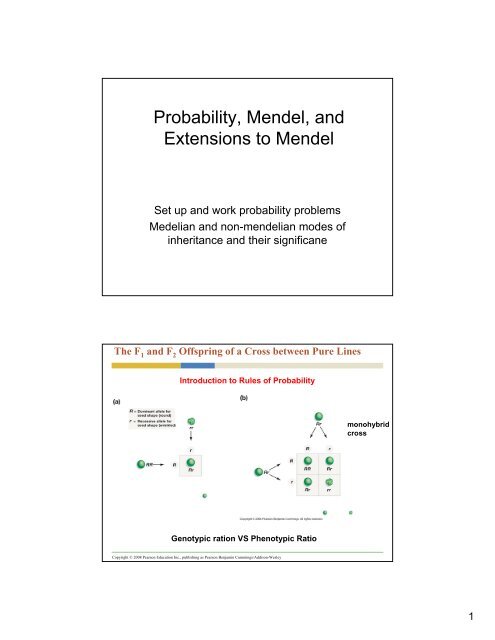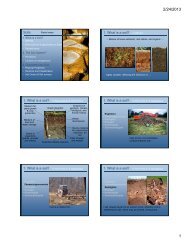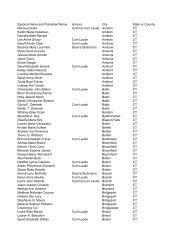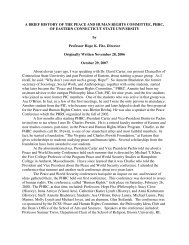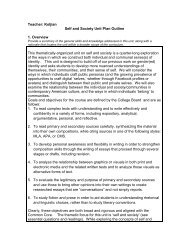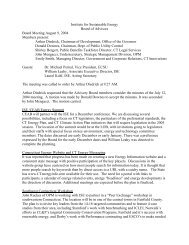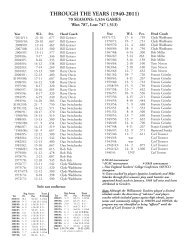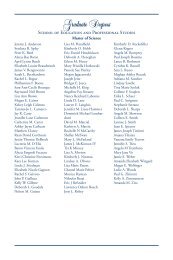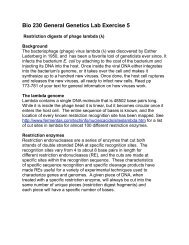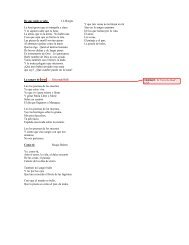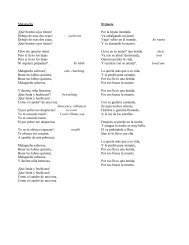Probability, Mendel, and Extensions to Mendel
Probability, Mendel, and Extensions to Mendel
Probability, Mendel, and Extensions to Mendel
Create successful ePaper yourself
Turn your PDF publications into a flip-book with our unique Google optimized e-Paper software.
<strong>Probability</strong>, <strong>Mendel</strong>, <strong>and</strong><br />
<strong>Extensions</strong> <strong>to</strong> <strong>Mendel</strong><br />
Set up <strong>and</strong> work probability problems<br />
Medelian <strong>and</strong> non-mendelian modes of<br />
inheritance <strong>and</strong> their significane<br />
The F 1 <strong>and</strong> F 2 Offspring of a Cross between Pure Lines<br />
Introduction <strong>to</strong> Rules of <strong>Probability</strong><br />
Genotypic ration VS Phenotypic Ratio<br />
Copyright © 2008 Pearson Education Inc., publishing as Pearson Benjamin Cummings/Addison-Wesley<br />
monohybrid<br />
cross<br />
1
Practice Problem<br />
• A homozygous yellow corn is crossed with a homozygous purple<br />
corn. The F1 offspring are crossed <strong>and</strong> produce 139 purple kernels<br />
<strong>and</strong> 61 yellow kernels (F2 offspring).<br />
• What is the genotype of the purple kernels in the P generation<br />
<strong>and</strong> the F1 generation?<br />
• Give a genetic explanation (mode of inheritance) for the<br />
differences in kernel color.<br />
Copyright © 2008 Pearson Education Inc., publishing as Pearson Benjamin Cummings/Addison-Wesley<br />
Chi-square Test<br />
• Are the observed data consistent with the data expected under the<br />
hypothesis being tested?<br />
Copyright © 2008 Pearson Education Inc., publishing as Pearson Benjamin Cummings/Addison-Wesley<br />
• χ 2 = Σ [(o-e) 2 / e] Values are significantly<br />
different from expected<br />
2
A Cross between Pure Lines for Two Traits<br />
F2 offspring genotypes:<br />
9/16 R–Y– : 3/16 R–yy : 3/16 rrY– : 1/16 rryy<br />
F2 offspring phenotypes: 9/16 : 3/16 : 3/16 : 1/16<br />
Copyright © 2008 Pearson Education Inc., publishing as Pearson Benjamin Cummings/Addison-Wesley<br />
Hypothesis of independent assortment:<br />
Alleles of different genes assort independently when gametes form.<br />
A Cross between Pure Lines for Two Traits<br />
Are these data are consistent with the<br />
predictions of independent assortment?<br />
<strong>Mendel</strong>’s results<br />
Conduct a X 2 Test.<br />
Copyright © 2008 Pearson Education Inc., publishing as Pearson Benjamin Cummings/Addison-Wesley<br />
3
Chi-square Test<br />
• Are the observed data consistent with the data expected under the<br />
hypothesis being tested?<br />
Copyright © 2008 Pearson Education Inc., publishing as Pearson Benjamin Cummings/Addison-Wesley<br />
• χ 2 = Σ [(o-e) 2 / e] Values are significantly<br />
different from expected<br />
Dihybrid cross: Phenotypic ratio 9:3:3:1<br />
• 9/16 dominant phenotypes at both genes<br />
(A_B_)<br />
• 3/16 dominant phenotype at first gene;<br />
recessive phenotype at second gene<br />
( A_bb)<br />
• 3/16 recessive phenotype at first gene;<br />
dominant phenotype at second gene<br />
(aaB_)<br />
• 1/16 recessive phenotypes at both genes<br />
(aabb)<br />
4
Dihybrid Cross problem solving<br />
• Memorize 9:3:3:1 or be able <strong>to</strong> reproduce it.<br />
• Not all genetics problems deal with dihybrids!<br />
• The genotypes may change by the principles<br />
are the same.<br />
Practice problems<br />
• P (dominant phenotype for both traits)<br />
• AaBBccDd X AAbbCcDd<br />
give P (AABbccDD offspring)<br />
•Forkline method for dihybrid<br />
Variations on <strong>Mendel</strong>’s Laws: Incomplete Dominance<br />
Flower color is variable in four-o’clocks.<br />
origin of ‘blending’ hypothesis?<br />
Copyright © 2008 Pearson Education Inc., publishing as Pearson Benjamin Cummings/Addison-Wesley<br />
5
Variations on <strong>Mendel</strong>’s Laws: Incomplete Dominance<br />
Incomplete dominance in flower color<br />
Parental<br />
generation<br />
F1 generation<br />
F2 generation<br />
Copyright © 2008 Pearson Education Inc., publishing as Pearson Benjamin Cummings/Addison-Wesley<br />
Self-fertilization<br />
Purple Lavender White<br />
Incomplete Dominance<br />
Heterozygote’s phenotype between those of<br />
the two homozygotes<br />
Example: Familial hypercholesterolemia<br />
(FH): normal alleles encode liver recep<strong>to</strong>rs<br />
for LDL cholesterol<br />
mutant alleles do not produce any recep<strong>to</strong>rs<br />
Phenotype measured by serum cholesterol<br />
levels.<br />
Heterozygote has ~ 1/2 the normal number<br />
of recep<strong>to</strong>rs<br />
Homozygote the mutant allele <strong>to</strong>tally lacks<br />
the recep<strong>to</strong>r (serum cholesterol level is very<br />
high)<br />
Monohybrid cross results in 1:2:1<br />
genotypic ratio <strong>and</strong> 1:2:1 phenotypic<br />
ratio.<br />
6
Variations on <strong>Mendel</strong>’s Laws: Co-Dominance<br />
• Human Blood type<br />
– I A I A or I A i<br />
– I B I B or I B i<br />
– I A I B<br />
– ii<br />
Copyright © 2008 Pearson Education Inc., publishing as Pearson Benjamin Cummings/Addison-Wesley<br />
Multiple Alleles: the Rule<br />
• An individual carries two alleles for each<br />
au<strong>to</strong>somal gene<br />
• However, a gene can have multiple alleles in<br />
the population because its sequence can<br />
deviate in many ways<br />
• Different allele combinations can produce<br />
variations in the phenotype<br />
• Examples:<br />
– ABO (3 alleles; four phenotypes);<br />
– PKU gene (hundreds of alleles; four basic<br />
phenotypes),<br />
– CF gene (>1500 alleles!; many phenotypes)<br />
7
• Multiple Alleles: I A ,<br />
I B , I 0<br />
• Each person still has<br />
only 2 alleles.<br />
• Co‐Dominance:<br />
Both alleles are<br />
expressed<br />
I A I B = type AB<br />
• Simple Dominant<br />
<strong>and</strong> Recessive: Both<br />
I A <strong>and</strong> I B are<br />
dominant <strong>to</strong> I 0<br />
ABO Blood Type<br />
Lethal Alleles<br />
• Alleles that are incompatible with life.<br />
• Result in missing or dead genotypic classes.<br />
• Recessive lethal = 2 copies required for death<br />
– Cystic fibrosis, sickle cell anemia<br />
– Homozygous recessive is missing or dies.<br />
• Dominant lethal = 1 copy required for death<br />
– Hunting<strong>to</strong>n’s disease, achondroplastic dwarfism<br />
– Heterozygotes <strong>and</strong> homozygous dominant are<br />
missing or die (homozygous dominants are typically<br />
very severely affected <strong>and</strong> often die early in<br />
development.<br />
8
PENETRANCE<br />
• PENETRANCE = proportion of a genotype<br />
showing the expected phenotype<br />
• Non‐penetrant = none show phenotype<br />
• Complete or 100% penetrance = all relevant<br />
genotypes express the trait<br />
• Incompletely penetrant = some show the trait,<br />
others do not<br />
• ALL OR NONE EXPRESSION OF A SINGLE GENE<br />
EXPRESSIVITY<br />
• EXPRESSIVITY = degree <strong>to</strong> which a phenotype<br />
is expressed<br />
• Variable Expressivity ~ range of phenotypes<br />
from slight <strong>to</strong> extreme<br />
• Variability in expression in different<br />
individuals<br />
• Variability in different parts of the same<br />
individual<br />
• Example: Polydactyly<br />
• SEVERITY OR EXTENT OF PHENOTYPIC<br />
EXPRESSION OF A SINGLE GENE<br />
9
Hunting<strong>to</strong>n’s Disease<br />
• Dominant lethal<br />
• Incomplete penetrance: disease is never<br />
manifested in some carriers.<br />
• Variable expressivity: appears at variable<br />
ages from infancy <strong>to</strong> old age.<br />
• Remains in populations because death<br />
typically occurs after reproductive age.<br />
Gene Interactions<br />
• > 1 gene pair contributes <strong>to</strong> the<br />
phenotype<br />
• Many, if not most, traits are the<br />
result of biochemical pathways.<br />
Each step is controlled by a<br />
different gene product.<br />
• Segregation <strong>and</strong> Independent<br />
Assortment hold<br />
• Phenotypic ratios are changed<br />
from 9:3:3:1 for 2 gene pairs<br />
• EPISTASIS = phenotypic<br />
expression of one gene pair hides<br />
the effect of another, different<br />
gene pair<br />
• Examples:<br />
– albinism (hides the effect of genes for eye color,<br />
skin color, hair color)<br />
– Bombay phenotype (hides the effect of ABO<br />
blood type genes)<br />
10
Bombay Phenotype<br />
AB AO<br />
AB O A B<br />
• A, B antigens are<br />
sugars + precursor<br />
• H gene controls<br />
synthesis of precursor<br />
• H = normal, dominant<br />
allele (can add sugars)<br />
• h = abnormal,<br />
recessive allele<br />
(cannot add A or B<br />
regardless of<br />
genotype)<br />
11


